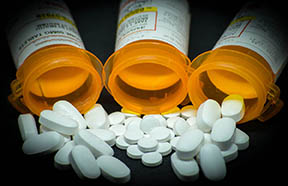

Litigating the Opioid Epidemic
“Opioids could kill nearly half a million people across America over the next decade as the crisis of addiction and overdose accelerates.”
That was the consensus of public health experts from 10 universities surveyed last summer by STAT, a public health news service.
Unlike most drug epidemics, the majority of opioid dependencies result from legitimate prescription treatment, including for workers’ compensation injuries such as lower back pain.
Employers, workers’ comp professionals, physicians and patients themselves need to be mindful of the lethal effects of opioid pain relievers. We’ll review some of the guidelines recommended by the Centers for Disease Control (CDC) for use of opioids in workers’ compensation claims. But first, we want to get you up to date on the latest attempts to hold drug makers accountable for their role in the epidemic.
More than 100 Lawsuits
Lawsuits against drug companies manufacturing opioids have now been filed by over 100 states, cities, counties and Native American tribes, and new suits are filed almost weekly. In March, South Dakota brought suit against Purdue Pharma L.P., a unit of Endo International P.L.C. and Johnson & Johnson’s Janssen for deceptive marketing practices and contributing to the nationwide drug epidemic. South Dakota was just the latest in a long list of states and other government entities suing drug makers for problems caused by opioids, which now result in nearly 100 deaths a day.
The latest round of lawsuits by public entities represents a different strategy from a few years ago, when private individuals were suing drug companies for personal injury from opioid addiction. Those claims alleged that opioid products were defectively designed, lacked sufficient warnings about addiction, and were misrepresented as safer than alternatives.
The hurdle for these plaintiffs was that most of their allegations were preempted by the fact that the drugs had FDA approval and that the duty to warn patients about risk rests with the doctors who prescribe them. Still, manufacturers settled many of these cases without admission of guilt.
Now though, there is a movement building to create a class action against opioid manufacturers, similar to the judgment that led to more than $200 billion in court-ordered payouts by the tobacco industry in 2000.
Similarities to Tobacco Settlement
Using a tactic that was successful against tobacco, government entities, like South Dakota and other states, are claiming that drug makers and distributors have disrupted their social systems by oversaturating the market and failing to control against misuse. To repair this public nuisance, states, counties, cities and Native American tribes need restitution, they say. This is the approach that worked against the tobacco industry.
In addition, they are alleging that drug companies falsely misrepresented the addictiveness of their products and made false representations about effectiveness. While there is no whistle-blower testimony that drug makers deliberately sought to deceive, as there was against the tobacco industry, admission of liability in settlements and documents obtained by government entities, investigative reporting and litigation are available to support the opioid claimants’ arguments.
Counties Would Get Money This Time, Too
These lawsuits differ from the tobacco litigation in that counties and cities are filing suits this time, too. When the states won their lawsuit against the tobacco companies, they kept the money. “None of it flowed down to the counties,” according to Paul Hanly, a partner with Simmons Hanly Conroy, which represents more than a dozen counties in opioid lawsuits, as reported in Governing magazine. The cities, counties and Native American tribes end up providing and paying for the health care and services opioid addicts need.
Pulling off a win like the states did against tobacco in 2000 might be a long shot. But win or lose, the current deluge of litigation “very publicly paints the opioid industry as contributing to the worst drug crisis in American history [and puts] wind in the sails of agencies and legislatures seeking stronger oversight. Together, litigation and its spillover effects hold real hope for arresting the opioid epidemic,” said Rebecca L. Haffajee, J.D., Ph.D., M.P.H., and Michelle M. Mello, J.D., Ph.D., writing in the New England Journal of Medicine.
Guidelines for Mitigating Opioid Addiction
- Encouraging treating physicians to follow current prescribing guidelines.
- Setting up prescription claims review programs to identify and address improper prescribing and use of painkillers.
- Increasing insurance coverage for other treatments to reduce pain, such as physical therapy, and for substance abuse treatment.
- Counseling patients on the benefits and risks of opioid use.
- Using psychological screening for individuals using opioids on a long-term basis.
- Requiring drug testing of individuals using opioids on a long-term basis.
- Referring individuals whose productivity or behavior changes to an employee assistance program (EAP) for evaluation and referrals if drug abuse is suspected.
For more information on using an EAP to prevent or address addiction issues in your workplace, please contact us.
Are You Ignoring Your Cyber Liability?
Litigating the Opioid Epidemic
How Drug Formularies Are Reducing Costs and Mitigating the Opioid Crisis
The information presented and conclusions within are based upon our best judgment and analysis. It is not guaranteed information and does not necessarily reflect all available data. Web addresses are current at time of publication but subject to change. SmartsPro Marketing and The Insurance 411 do not engage in the solicitation, sale or management of securities or investments, nor does it make any recommendations on securities or investments. This material may not be quoted or reproduced in any form without publisher’s permission. All rights reserved. ©2017 The Insurance 411. Tel. 877-762-7877. www.theinsurance411.com